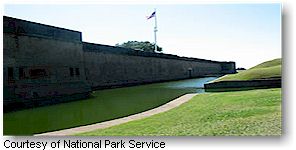|
 The defining events of Fort Pulaski occurred during the American Civil War. In April of 1862, Union troops directed rifled cannon fire at the fort breaching the southeast angle. The quick success of this experimental cannon surprised military strategists. The accuracy and range of the rifled cannon rendered brick fortifications obsolete. Immediately after capturing the fort, Union Major General David Hunter, an ardent abolitionist, ordered the release of area slaves. Many were recruited into the Union army comprising the First South Carolina Colored Regiment. The defining events of Fort Pulaski occurred during the American Civil War. In April of 1862, Union troops directed rifled cannon fire at the fort breaching the southeast angle. The quick success of this experimental cannon surprised military strategists. The accuracy and range of the rifled cannon rendered brick fortifications obsolete. Immediately after capturing the fort, Union Major General David Hunter, an ardent abolitionist, ordered the release of area slaves. Many were recruited into the Union army comprising the First South Carolina Colored Regiment.
The park includes scenic marsh and uplands that support a variety of animal life characteristic of southern barrier islands. White-tailed deer, alligators, and raccoons as well as resident and migratory birds grace the landscape. Spanish moss drapes from yaupon holly bushes and vegetation includes cabbage palms, various wetland grasses, and a variety of temperate hardwood and pine trees.
A short film on the history of Fort Pulaski, including the role it played in the Underground Railroad network is shown daily at the visitors center. Daily interpretive programs are available as well special interpretive programs on musket and cannon demonstrations throughout the year. Visitor can also enjoy the short hiking trails and self-guided Fort tours.
Fees:
Adults - $3
Children ages 15 and under - Free
Getting There:
Follow U.S. HWY 80 East toward Tybee Island, Georgia. The entrance is located about fifteen miles east of Savannah, Georgia.
|



